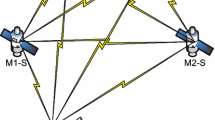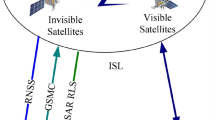Abstract
The introduction of an intersatellite link, also called a crosslink, is considered a promising technique for improving the reliability and integrity of a global navigation satellite system. As one of the most rapidly developing satellite navigation systems, the BeiDou system launched from March 2015 to February 2016 an in-orbit validation constellation that includes two inclined geosynchronous orbit satellites and three medium earth orbit satellites equipped with an intersatellite link in the Ka band. We modeled the intersatellite measurements of BeiDou and evaluated the ranging performance of the intersatellite link based on the analysis of in-orbit measurement data. We used both residual analysis and external data comparison to assess the data. The results show that the ranging precision of the BeiDou intersatellite link is within 10 cm and is determined mainly by the thermal noise of the receiver. Moreover, the drift rate of the group delay of the transceiver channel is within 1 cm per day.










Similar content being viewed by others
References
Abusali P, Tapley B, Schutz B (1998) Autonomous navigation of global positioning system satellites using cross-link measurements. J Guid Control Dyn 21(2):321–327
ESA (2012) GNSS Evolution factsheet. ESA. https://esamultimedia.esa.int/docs/Navigation/ fact-sheet-GNSS-evolution.pdf. Accessed 1 Mar 2018
Fernández FA (2011) Inter-satellite ranging and inter-satellite communication links for enhancing GNSS satellite broadcast navigation data. Adv Space Res 47(5):786–801
Gerlin F, Laurenti N, Naletto G, Vallone G, Villoresi P, Bonino L, Mottini S, Sodnik Z (2013) Design optimization for quantum communications in a GNSS intersatellite network. In: Proc. 2013 international conference on localization and GNSS (ICL-GNSS), Turin, 25–27 Jun, pp 1–6
Guo R, Hu X, Tang B, Huang Y, Liu L, Cheng L, He F (2010) Precise orbit determination for geostationary satellites with multiple tracking techniques. Chin Sci Bull 55(8):687–692
Kaplan E, Hegarty C (2005) Understanding GPS: principles and applications. Artech House, Norwood
Li X, Wang Y, Yang J, Chen J (2014) Power allocation in inter-satellite ranging measurement of navigation constellation. IEEE Commun Lett 18(5):801–804
Lin Y, He S, Zheng J, Chu H (2010) Development recommendation of inter-satellites links in GNSS. Spacecr Eng 19(6):1–7
Mao Y, Song X, Jia X, Wu X (2013) Naturalisation method research on inter-satellite link observation data. Geomat Inf Sci Wuhan Univ 38(10):1201–1206
Pan J, Hu X, Zhou S, Tang C, Guo R, Zhu L, Tang G, Hu G (2018) Time synchronization of new-generation BDS satellites using inter-satellite link measurements. Adv Space Res 61(1):145–153
Pasinkov VV, Shargorodsky VD, Sadovnikov MA, Sumerin VV (2013) The concept and the preliminary results of the SLR application in the problem of improving the GLONASS accuracy. In: Proc. the 18th international workshop on laser ranging, Fujiyoshida, 11–15 Nov, pp 1–6
Rajan JA, Orr M, Wang P (2003) On-orbit validation of GPS IIR autonomous navigation. In: Proc. ION AM, Institute of Navigation, Albuquerque, 23–25 June, pp 411–419
Sonntag HE (1997) Block IIR UHF crosslink enhancements study. In: Proc. ION NTM 1997, Institute of Navigation, Santa Monica, 14–16 Jan, pp 819–828
Xiao Z, Huang W, Yang J, Song S, Xie H (2016) A precision evaluation method for inter-satellite link measurement of Ka band based on SLR. In: Proc. China satellite navigation conference (CSNC) 2015 proceedings, Xian, 13–15 May, pp 459–467
Xu Y, Chang Q, Yu Z (2012) On new measurement and communication techniques of GNSS inter-satellite links. Sci China Technol Sci 55(1):285–294
Acknowledgements
The authors wish to acknowledge Dr. Xiaogong Hu, Professor of Shanghai Astronomy Observatory, Chinese Academy of Science, for his helpful instruction in the writing of this paper and Dr. Hui Lei, National Time Service Center, Chinese Academy of Science, for providing the C-band observation data. Satellite laser ranging measurements of the BDS satellites were kindly provided by Changchun artificial earth satellite observation station and the International Laser Ranging Service (ILRS). Their support is also appreciated and gratefully acknowledged. This work was supported by a grant from the China Postdoctoral Science Foundation (Grant No. 2015M580365).
Author information
Authors and Affiliations
Corresponding author
Rights and permissions
About this article
Cite this article
Zhou, Y., Wang, Y., Huang, W. et al. In-orbit performance assessment of BeiDou intersatellite link ranging. GPS Solut 22, 119 (2018). https://doi.org/10.1007/s10291-018-0784-0
Received:
Accepted:
Published:
DOI: https://doi.org/10.1007/s10291-018-0784-0




